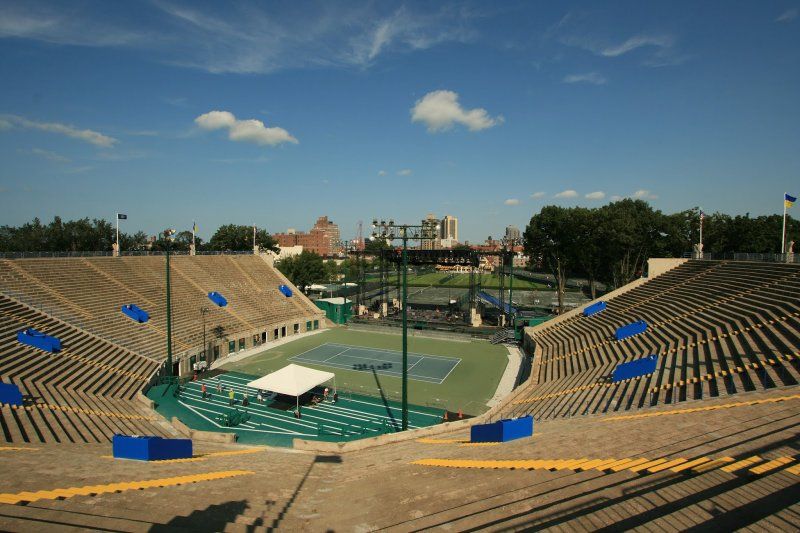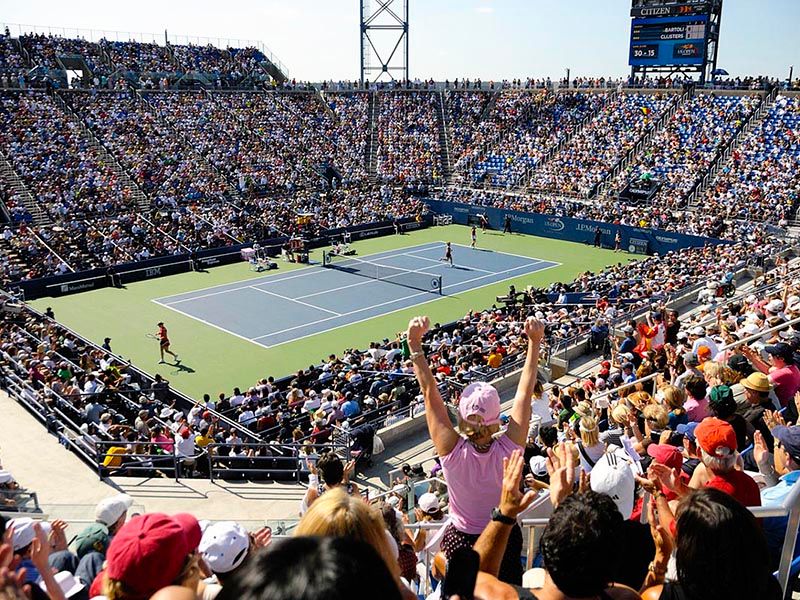Last Chance to Catch NYC's Holiday Notalgia Train
We met the voices of the NYC subway on our nostalgia ride this weekend!

Uncover the surprising history of the U.S. Open Tennis Championships, played each year at Flushing Meadows-Corona Park in Queens!

The U.S. Open has been held at Flushing Meadows–Corona Park since 1978 and brings in thousands of tennis enthusiasts from around the world each year. However, the U.S. Open was not always as it is today. Here are 10 secrets and fun facts about this illustrious tournament.

It might be hard to imagine today, as the U.S. Open is firmly established in people’s minds as a hard-court tournament, but the champion tennis players rallied on grass from 1881 to 1974. The U.S. National Lawn Tennis Association hosted the first tournament, which was held at the Newport Casino in Rhode Island. During this time period, the tournament was known as the “U.S. National Singles Championship.” This was, by all accounts, more of an upper-crust, social event. Until 1886, the tournament was also men-only. The U.S. Women’s National Singles Championship started in 1887 and was held in Philadelphia at the Philadelphia Cricket Club.

The U.S. Open was played briefly on clay from 1975 to 1977, making it the only major tournament to have been played on three surfaces. Tennis icon Jimmy Connors won the U.S. Open on all three surfaces, while Chris Evert won on two — clay and hard court.
The clay material was technically called HarTru, an igneous crushed basalt stone from the Catoctin Mountains of Maryland. The gray-green color comes from epidote, a mineral that is in the stone. HarTru is a faster material than European red clay, and it is said that the change to clay was an attempt to make the tournament more television-friendly, as it created more contrast between the surface and the ball and induced a slower game.

From 1881 to 1914, the U.S. National Singles Championship was held at the Newport Casino in Rhode Island. The push to move the tournament to New York City began as early as 1911 by a group of New York tennis players. A New York Times article from February 1911 that covered a contentious vote about the club’s move stated that “The arguments were powerfully arrayed against Newport,” but there was no “bona-fide application from any responsible club to hold the tournament elsewhere.” As a result, those in favor of the move lost the vote 60 to 95. By 1915, however, 100 members signed a petition to move the club and won the official vote.
From 1915 to 1921, the tournament occurred at the West Side Tennis Club in Forest Hills, Queens, following a few years at the Germantown Cricket Club in Philadelphia during which the Forest Hills Tennis Stadium was being built. In 1968, the tournament became the U.S. Open, and in 1978, the tournament moved to Flushing Meadows-Corona Park to accommodate larger crowds. The West Side Tennis Club still attempted to block the move.

The West Side Tennis Club predates the U.S. Open, as well as the construction of Forest Hills itself. Established in 1892, the c;ub was instrumental in the establishment of the sport of tennis in the United States. Completed in 1923, the 14,000-seat stadium in Forest Hills was the first concrete tennis stadium in the country. The architect behind the stadium was Kenneth M. Murchison, who also worked on Baltimore’s Penn Station and the Hoboken Terminal. The U.S. Open was played here first on clay, and then on hard courts starting in 1975. The stadium has hosted tennis icons like Billie Jean King, Margaret Court, and Bill Tilden, as well as musicians like Frank Sinatra, Bob Dylan, and the Beatles in the 1960s. There was also a shooting and bomb threat during a particularly scandalous 1977 season.
In 2011, the stadium was denied landmark status by the Landmarks Preservation Commission, which called it a “crumbling ruin,” and the structure was almost demolished to make way for condos. The preservation, restoration, and repurposing of the stadium into a concert music venue, an initiative pushed for many years by the Rego-Forest Preservation Council (a grassroots campaign started by local resident Michael Perlman and other local supporters) helped preserve the historic archways, eagles, terra-cotta shields, and wood and iron grandstands. A stately Tudor-style clubhouse, designed by Grosvenor Atterbury and John Almay Tompkins, was built in 1913.

The U.S. National Singles Championship was initially only open to members of clubs that were part of the U.S. National Lawn Tennis Association. According to the U.S. Open website, “Prior to 1968, the grand irony of the sport of tennis was that those who were skilled enough to play it as a profession were not allowed to play it at any of the sport’s major events. Tennis’ best players were, in fact, pariahs in a sport in which they should have been pillars.”
From 1884 to 1911, the game so favored prior champions that the winner would automatically qualify for the final in the next year. In 1968, the tournament became the “U.S. Open,” combining the men, women, men and women doubles, and mixed doubles tournaments, and allowing for professional players to compete.

Albeit with significant alteration, the original Louis Armstrong and Grandstand stadiums at the U.S. Open were divided from the Singer Bowl, a stadium constructed by the Singer Sewing Company for the 1964 World’s Fair. After the World’s Fair, it was used for hosting concerts, Olympic trials, and professional boxing events. The Doors, The Who, and Jimi Hendrix performed there, while the Mets had a fireworks display on premise to celebrate the 1969 World Series win.
The Louis Armstrong Stadium and the Grandstand were the main venues for the U.S, Open until Arthur Ashe Stadium was constructed in 1997. This is the stadium used today for the tournament, In 2017, a new Grandstand was opened and the Louis Armstrong Stadium was rebuilt from the ground up.

In literature, the Corona Ash Dump was immortalized and romanticized by F. Scott Fitzgerald’s The Great Gatsby as the “valley of ashes.” The city’s coal-burning refuse was taken here along with garbage. On a former marshland rose dusty, high mounds through which the Long Island Railroad ran, along with Grand Central Parkway. Scavenging by both humans and rats was a common occurrence. Like many other areas targeted by Robert Moses, the Corona Ash Dumps underwent a massive transformation. Moses pushed for the eviction of residents and businesses around the time of the 1939 World’s Fair.
Moses was active in trying to lure sports to Flushing Meadows, with his most famous (and failed) attempt to move the Dodgers from Ebbets Field. In a bid to negotiate a move to Atlantic Yards, Dodgers owner Walter O’Malley opened the possibility of moving the Dodgers to Los Angeles. When Moses wouldn’t offer up Atlantic Yards, O’Malley took the California offer. For the U.S. Open, the city was “throwing permits at us,” recalled Randy Gregson, former U.S.T.A. president and a friend of William Slew Hester, the U.S.T.A. President that engineered the move from the West Side Tennis Club. Moses would have to be content with tennis.

The U.S. Open at Forest Hills is where Althea Gibson broke the color barrier to become the first African American woman to compete on the world tennis tour, and where she won a Grand Slam in 1956. It is also where Arthur Ashe became the first African American to win the U.S. Open in 1968. This inaugural men’s final was when the tournament officially became known as the “U.S. Open.”
The main stadium at the USTA Billie Jean King National Tennis Center, the name of the complex today is is the Arthur Ashe Stadium. The stadium honors Ashe’s contributions to the realms of tennis and the U.S. Open. Other institutions donning his name continue to expand the accessibility of tennis. According to the U.S. Open website, the Arthur Ashe Kids Day is the “largest single-day, grassroots tennis and entertainment event in the world, with chart-topping music acts and today’s best tennis players coming together to celebrate tennis legend and humanitarian Arthur Ashe.”
Before the retractable roof was installed in the Arthur Ashe Stadium, rain would be dried off the courts using a fleet of Zamboni-like machines. As of 2004, there were 38 of these machines, nicknamed the “Slambonis” which were designed for the courts at the U.S. Open. When the “Slambonis” first debuted, it was estimated that using them saved about 10 minutes of play for each interrupted game. They hold 30 gallons of water, sponging and vacuuming the courts at the same time. Blowing hot air damages the surfaces, so heating machinery was ruled out in the development of the machines.
Equally important, the Slambonis had to be up to city codes. As Chris Widmaier, the U.S.T.A.’s senior director of public relations at the time, said, “Because of fire department codes, we cannot keep much gas on the premises, so we had to look at electrically powered or battery-operated machines. And the machines had to be narrow enough to get through the narrow entrances and exits.”

The U.S. Open’s first home is now the International Tennis Hall of Fame in Newport, Rhode Island, and when the tournament began, it was part of the Newport Casino. The Newport Casino was never a place for gambling, but the word casino was a term for a social club during the Gilded Age, derived from the Italian word casa. Commissioned by newspaper owner James Gordon Bennett Jr., the now Hall of Fame was designed by Charles McKim and Stanford White, of McKim, Mead & White. Stanford White also designed the Venetian palazzo-inspired headquarters of the New York Herald for Bennett Jr., on the site that is now Herald Square.
The shingled, manor-style complex was intended to feel like the country clubs of England, which makes sense given that the American elite of this era were desperate to demonstrate to its European counterparts that it was equal in prestige. The creation of Central Park and Prospect Park fall into this effort, along with the modeling of Eastern Parkway in Brooklyn after the Champs-Élysées and Avenue Foch in Paris.
Next, check out the Top 10 Secrets of Flushing Meadows-Corona Park!
Originally published August 2023
Subscribe to our newsletter